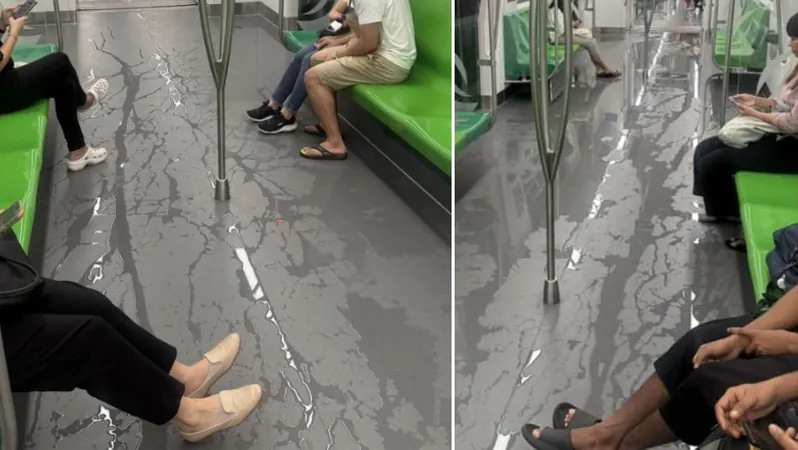
Rain or Shine, Singapore's East-West Line Sparks Heated Debate Among Commuters!
2024-10-15
Author: Wei Ling
SINGAPORE: The East-West Line has recently found itself under scrutiny as commuters share their grievances about unexpected wet conditions inside the trains.
Following a series of disruptions earlier this month, passengers were greeted by puddles inside train cabins after heavy rainfall on Monday morning, October 14.
Don Seah took to Facebook, sharing two photos that vividly captured the situation—a cabin floor with small rivulets and water pooling in various spots. His post, titled, “1st world transportation. East-West line! Not rainproof!” quickly gained traction, illuminating a common yet contentious issue.
In Seah’s photos, one woman is seen perched with her feet off the ground to avoid soaking her shoes, yet remarkably, the cabin was sparsely populated—a small mercy during the downpour. This prompted a lively discussion in the Complaint Singapore Facebook group, where opinions on the matter varied dramatically.
Diverse Reactions from Commuters
Some users were quick to dismiss the complaints. One commenter remarked, “Eh deh. Your first day? Heavy rain will cause the water to come inside MRT la. Duh,” reminding others that such occurrences have been part of the experience since the first trains hit the tracks decades ago.
Another surprisingly pointed out that even the intentional rainproof seals can succumb to severe downpours, suggesting a more grateful attitude towards the country’s robust transport system.
A few participants highlighted the impact of dripping umbrellas from passengers boarding and disembarking the train, contributing to the wet floors. “When your house door and window open during heavy rain with strong wind, sure will get splashed,” a user noted, emphasizing that it’s the act of commuting during rain—rather than infrastructural deficiencies—that leads to the soggy experience.
Frustration Among Commuters
Conversely, not all commuters were satisfied with these explanations. One user countered, “I don’t remember any train I’ve ever sat in getting wet during rain,” while another echoed frustration, stating, “Getting from bad to worse... Last time, no matter how heavy the rain was, I had never seen this situation.”
This conversation has ignited a broader debate about public transport maintenance and expectations in urban environments. How do other international systems manage similar issues? Is it realistic to expect complete dryness amidst heavy storms, or should commuters partner with transit authorities to seek improvements?
The Broader Debate
Singapore’s East-West Line, like many urban transit systems, must continue to adapt—balancing operational effectiveness with the challenges posed by unpredictable weather patterns. As discussions persist, one thing remains clear: public transport experiences during inclement weather will always spark dialogue.


 Brasil (PT)
Brasil (PT)
 Canada (EN)
Canada (EN)
 Chile (ES)
Chile (ES)
 España (ES)
España (ES)
 France (FR)
France (FR)
 Hong Kong (EN)
Hong Kong (EN)
 Italia (IT)
Italia (IT)
 日本 (JA)
日本 (JA)
 Magyarország (HU)
Magyarország (HU)
 Norge (NO)
Norge (NO)
 Polska (PL)
Polska (PL)
 Schweiz (DE)
Schweiz (DE)
 Singapore (EN)
Singapore (EN)
 Sverige (SV)
Sverige (SV)
 Suomi (FI)
Suomi (FI)
 Türkiye (TR)
Türkiye (TR)